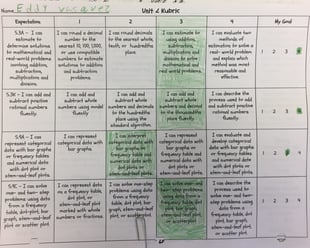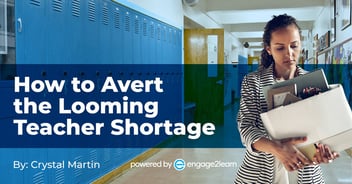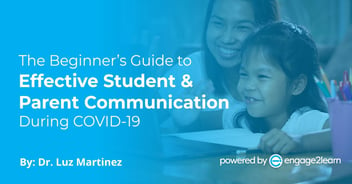Is it Time to Revolutionize the Grading System? | engage2learn
Quick question: If we are finally realizing the importance of creating learning environments that reflect life outside of the classroom, then why haven’t we changed our grading system?
It’s safe to say that education has drastically changed in the last 20+ years. We’re on a mission to move our classrooms from teacher-driven to student-centered. Our classrooms look different, sound different, and feel different than the conventional classrooms of the past. It’s not uncommon to walk into a room and see students collaborating over ways to solve a problem, creating a project, utilizing technology, conferring with a teacher, participating in a debate, or working comfortably in a space of their choice.
Educators continue to find innovative ways to challenge students to prepare them for their future. Still, they are finding it more and more difficult to “grade” student work using conventional grading methods. Campus and district grading policies leave teachers contemplating how they’ll reach their weekly grade quota, so it’s no wonder they are hesitant to abandon the old grading system.
According to NACE, National Association of Colleges and Employers, the 2019 Job Outlook Survey identified the following attributes that employers are seeking:
- Communication skills (written)
- Problem-solving skills
- Ability to work in a team
- Initiative
- Analytical/ quantitative skills
- Strong work ethic
- Communication skills (verbal)
- Leadership
- Detail-oriented
- Technical skills
- Flexibility/Adaptability
- Computer skills
- Interpersonal skills
- Organizational ability
- Strategic planning skills
- Tactfulness
- Creativity
- Friendly/outgoing personality
- Entrepreneurial skills/risk-taker
- Fluency in a foreign language
What does this information mean for how and for what we are preparing our students? Transitioning the learning environment from teacher-centered to learner-centered is a direct response to the ever-changing, competitive world that they will enter upon graduation. Preparing students for their next steps means that we have to offer students the opportunities to make choices and solve problems. If we do the thinking for them, we are robbing them of a quality education that prepares them for the 21st century.
The old algorithms of student assessment are out of date with the needs of the 21st-century workplace. When our company partners with districts to design a learning framework, we start with identifying what learner outcomes the district and community hope to see their students acquire during a lesson cycle. There is a heavy emphasis on hard-to-measure skills such as teamwork, creativity, iteration, problem-solving, work ethic, and planning, but how do we measure these appropriately?
Measuring Learning through Rubrics
At engage2learn (e2L), we know the power in providing authentic learning experiences. This is the bread and butter of our professional development and teacher coaching. We believe that providing students with relevant, authentic learning opportunities will yield a high return on investment. In e2L’s blog post, Learning Should be Real, Not “Real” by Olive May, she emphasizes that when students have the opportunity for real learning for a real reason, then the depth of learning is maximized.
For example, when students are introduced to the Pythagorean theorem, they are memorizing a formula, and more often than not, they have a difficult time processing the concept. I was helping a student in his 8th-grade summer school class and instead of the teacher having students repeat the Pythagorean theorem over and over, she understood that they needed to understand it first. She had students design an awning for the high school that would allow students to wait out of the weather. When they began to design their plans, they were required to use the theorem to calculate the materials needed for the awning. The most cost-effective plan would go to the school board. Students were excited about their project, and they were definitely learning! The only thing that could have elevated her instruction would have been to assess their progress. Unfortunately, real learning can be really hard to assess.

Utilizing standards-aligned rubrics are the most efficient and accurate pathways to assess learning. Not only do rubrics identify the standards that need to be mastered, they also communicate to learners where they are and where they need to be. Understanding this reality helps students in creating a plan for their personal success. Using rubrics in the classroom can be intimidating at first, but the effects are so worth it! Arlington ISD 4th-grade teacher, Audriuna Gordon, shares her experience with using rubrics in the classroom, “Rubrics let me know exactly what gaps I need to fill, instead of just saying that I think they (the students) are low or high.” Rubrics give specific feedback that numerical and letter grades don’t provide.

Had that 8th-grade teacher developed a rubric aligning to the Pythagorean theorem standards, she would’ve known exactly how to assist her students in their learning.
When planning for authentic learning, it’s important to ensure that students have the opportunity to grow skills such as problem-solving, collaboration, creativity, growth mindset, and professional ethics. Using the e2L Life Ready Rubrics are the best way to assess these hard-to-measure skills that prepare them for real life, the characteristics that employers are identifying as essential to the success of their companies.
Grading and Differentiating
As a teacher coach, I hear a lot of discussion from classroom teachers about how to differentiate and use the traditional grading system. We know that personalizing learning through differentiation is what is best for students and the only way to close learning gaps. Still, it’s hard to tell on a report card what the child truly knows if the only information given is in the form of a number or letter grade. Did the child receive multiple opportunities to achieve their learning, or did mastery happen during their first attempt? Is the student working on resources and materials that are on grade level?
Using a rubric will clarify exactly where the child is on the spectrum of learning, and the instructor can properly identify ways to differentiate for the student. It’s difficult to align differentiated resources and learning opportunities without fully understanding what the student knows.
Should Grading Systems Go?
While I am a firm believer in assessing student progress toward mastery, I also know that there are many ways to assess what students know. Let’s not be afraid to let students create, iterate, problem solve, collaborate, and take risks! If students can learn those skills and learn content at a deeper level through authentic opportunities, then they are sure to find success on standardized tests. Perhaps it’s time for us to abandon old habits and consider the ways in which our grading system should mirror what the workforce demands?



